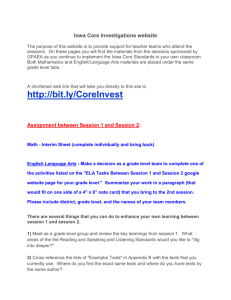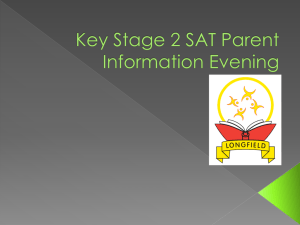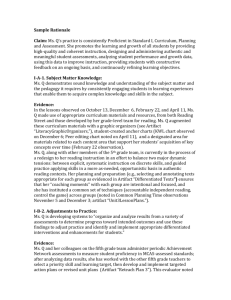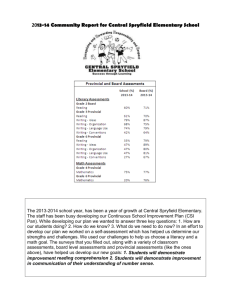English Policy - St Francis Catholic Primary School
advertisement
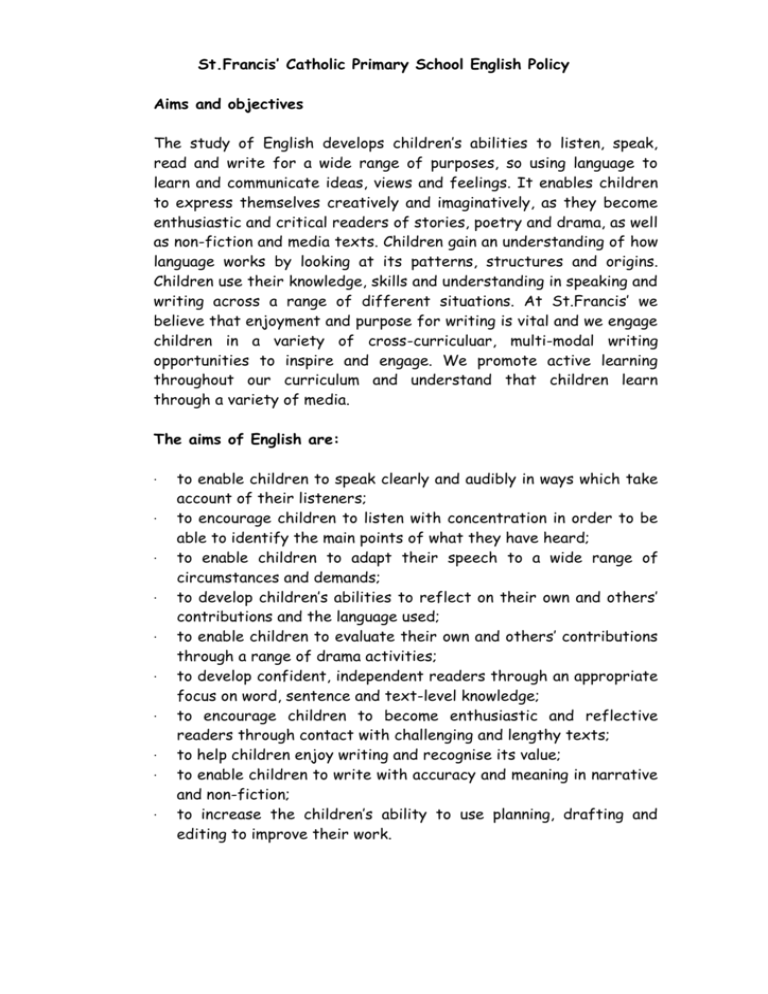
St.Francis’ Catholic Primary School English Policy Aims and objectives The study of English develops children’s abilities to listen, speak, read and write for a wide range of purposes, so using language to learn and communicate ideas, views and feelings. It enables children to express themselves creatively and imaginatively, as they become enthusiastic and critical readers of stories, poetry and drama, as well as non-fiction and media texts. Children gain an understanding of how language works by looking at its patterns, structures and origins. Children use their knowledge, skills and understanding in speaking and writing across a range of different situations. At St.Francis’ we believe that enjoyment and purpose for writing is vital and we engage children in a variety of cross-curriculuar, multi-modal writing opportunities to inspire and engage. We promote active learning throughout our curriculum and understand that children learn through a variety of media. The aims of English are: · · · · · · · · · · to enable children to speak clearly and audibly in ways which take account of their listeners; to encourage children to listen with concentration in order to be able to identify the main points of what they have heard; to enable children to adapt their speech to a wide range of circumstances and demands; to develop children’s abilities to reflect on their own and others’ contributions and the language used; to enable children to evaluate their own and others’ contributions through a range of drama activities; to develop confident, independent readers through an appropriate focus on word, sentence and text-level knowledge; to encourage children to become enthusiastic and reflective readers through contact with challenging and lengthy texts; to help children enjoy writing and recognise its value; to enable children to write with accuracy and meaning in narrative and non-fiction; to increase the children’s ability to use planning, drafting and editing to improve their work. Learning Environment Our classrooms and displays are used as learning tools. Using the learning environment all skills are transferrable and learning is applied across a range of contexts, ensuring intrinsic links between reading, writing, phonics, grammar, spelling and punctuation are made and children are regularly given time to consolidate learning. Through the learning environment children are empowered and supported to build independence when working We have Literacy rich classrooms which have evidence of; - Differentiation offering all children the opportunity to make progress in Literacy learning. - High frequency words on display and/or accessible on tables to support children. - Letter sounds, spelling rules and conventions to support writing. - Success criteria linked to specific genre of writing. - Level descriptors on show for children to be reminded how to uplevel writing and take ownership of their writing. - Children being engaged through a wide range of modes such as: drama, oral presentation, visual, and kinaesthetic activities. - Modelled expectations available for reference. - Easily accessible reference material such as spelling dictionaries and thesauruses in all classrooms. Dictionaries kept in children’s desks. Working Walls Every class has a Literacy Working Wall; • This evolves as each day progresses. It is the public display of the learning process. It clearly displays the long term learning objectives as well as short term intentions. • The success criteria are developed with the children and displayed. They are used to demonstrate to pupils how they will be able to achieve the learning intention. • Exemplified text-types. • Key vocabulary is also displayed. Mind mapping, modelled examples, re-drafting and pupils’ examples are regular features of the working wall. Teaching and learning style At St.Francis’ School we use a variety of teaching and learning styles in English lessons and follow the New National Curriculum statutory requirements. Our principal aim is to develop children’s knowledge, skills, and understanding in English. We do this through teaching daily interactive lessons that have a balance between teacher led and child facilitated learning, taking into account differentiation and challenge. Assessment for learning is embedded throughout the curriculum and all children have target bookmarks where they coment upon their own work and set themselves targets, where peers can assess work and give targets and where the class teacher can write targets. These are laminated therefore giving the flexibility for the targets to change as often as appropriate. Children use ICT in English lessons where it enhances their learning, as in drafting their work and using multimedia to study how words and images are combined to convey meaning. Wherever possible we encourage children to use and apply their learning in other areas of the curriculum. English curriculum planning English is a core subject in the National Curriculum. We use the National Curriculum as the basis for implementing the statutory requirements of the programme of study for English in Key stage 1 and Key Stage 2. Our medium-term plans, which we also base on the Framework, give details of the main teaching objectives for each term. These plans define what we teach and ensure an appropriate balance and distribution of work across each term. The English subject leader is responsible for keeping and reviewing these plans. Class teachers complete a weekly (short-term) plan for the teaching of English. This lists the specific learning objectives for each lesson and gives details of how the lessons are to be taught. It also includes details of what each group of children will be learning. The class teacher keeps these individual plans, and the class teacher and subject leader often discuss them on an informal basis. The Early Years Foundation Stage We teach English in reception classes as an integral part of the school’s work. We relate the English aspects of the children’s work to the objectives set out in the Early Learning Goals which underpin the curriculum planning for children aged three to five. In the EYFS Communication and Language development is integral to develop the child’s listening, understanding and speaking skills and is a ‘Prime area’ of importance. Literacy is split into two separate areas which are Reading and Writing. We give all children the opportunity to talk and communicate in a widening range of situations, to respond to adults and to each other, to listen carefully, and to practise and extend their range of vocabulary and communication skills. They have the opportunity to explore, enjoy, learn about, and use words and text in a range of situations. Contribution of English to teaching in other curriculum areas The skills that children develop in English are linked to, and applied in, every subject of our curriculum. The children’s skills in reading, writing, speaking and listening enable them to communicate and express themselves in all areas of their work in school. Mathematics English contributes significantly to the teaching of mathematics in our school. Children in the Foundation Stage develop their understanding of number, pattern, shape and space by talking about these areas with adults and other children. Children in Key Stage 1 meet stories and rhymes that rely on counting and sequencing. Children in Key Stage 2 are encouraged to read and interpret problems in order to identify the mathematics involved. They explain and present their work to others during plenary sessions and they communicate mathematically through the developing use of precise mathematical language. Information and communication technology (ICT) The use of ICT enables children to use and apply their developing skills in English in a variety of ways. Younger children use ICT as a source of information and as a way of enabling them to present their completed work effectively. Older children use the Internet when searching for information about a different part of the world, or when using desktop publishing to design a class newspaper. Children use the planning and proofing tools in a word processor when checking their draft work. We encourage all children to use ICT as a resource for learning, whenever they feel it is appropriate. Personal, social and health education (PSHE) and citizenship English contributes to the teaching of personal, social and health education and citizenship. We encourage younger children to take part in class and group discussions on topical issues. In their science work they talk about things that improve their health and about rules for keeping them safe around the school. Older children research and debate topical problems and events. They discuss lifestyle choices and meet and talk with many visitors who work within the school community. Planned activities within the classroom encourage children to work together and respect each other’s views. Spiritual, moral, social and cultural development The teaching of English develops skills through which our children can give critical responses to the moral questions they meet in their work. Their understanding and appreciation of a range of texts brings them into contact with their own literary heritage and texts from other cultures. The organisation of lessons allows children to work together and gives them the chance to discuss their ideas and results. Teaching English to children with special needs At St.Francis’ School we teach English to all children, whatever their ability. English forms part of the school curriculum policy to provide a broad and balanced education to all children. Teachers provide learning opportunities matched to the needs of children with learning difficulties. Work in English takes into account the targets set for individual children in their Individual Education Plans (IEPs). Teachers provide help with communication and literacy through: · using texts that children can read and understand; · using visual and written materials in different formats; · using ICT, other technological aids and taped materials; · using alternative communication such as signs and symbols; · using translators and amanuenses. Assessment and recording Teachers assess children’s work in English in three phases. The short-term assessments that teachers make as part of every lesson help teachers to adjust their daily plans. Teachers match these short-term assessments closely to the teaching objectives. They use medium-term assessments to measure progress against the key objectives, and to help them plan for the next unit of work. They use a class record of the key objectives as the recording format for this. Teachers make long-term assessments towards the end of the school year, and they use these to assess progress against school and national targets. With the help of these long-term assessments, teachers are able to set targets for the next school year and summarise the progress of each child before discussing it with the child’s parents. The next teacher also uses these long-term assessments as the basis for planning work for the new school year. These long-term assessments are made using end-of-year tests and teacher assessments. Children undertake the national tests at the end of Year 2 and Year 6, plus the optional national tests at the end of Years 3, 4 and 5. Teachers also make annual assessments of children’s progress using the level descriptions of the National Curriculum. The subject leader keeps samples of children’s work in a portfolio. This demonstrates what the expected level of achievement is in English in each year of the school. Teachers meet regularly to review individual examples of work against the national exemplification material produced by the STA and the DfEE. All children have a writing portfolio, which follows the child throughout school and is an exemplar of their writing abilities. Highlighted grids indicate where the child is within age related expectations enabling the next teacher to pick up on and deliver next step targets. Resources There is a range of resources to support the teaching of English across the school. All classrooms have dictionaries and a range of age-appropriate small apparatus. Each classroom has a speaking and listening area with a tape recorder and a range of audio texts. All classrooms have a selection of fiction and non-fiction texts. Children have access to the Internet through their classroom computer. Access to the Internet is also available in the library area. Audiovisual aids are also available from the central storage area. The library contains a range of books to support children’s individual research. Monitoring and review Monitoring of the standards of the children’s work and of the quality of teaching in English is the responsibility of the English subject leader and all staff. The work of the subject leader also involves supporting colleagues in the teaching of English, being informed about current developments in the subject, and providing a strategic lead and direction for the subject in the school. The subject leader gives an annual summary report in which s/he evaluates the strengths and weaknesses in the subject, and indicates areas for further improvement. The leader has specially-allocated regular management time in order to enable him/her to review samples of the children’s work and undertake lesson observations of English teaching across the school. The named governor responsible for literacy meets regularly with the subject leader in order to review progress. Signed:S.Deakin Date: September 2015

